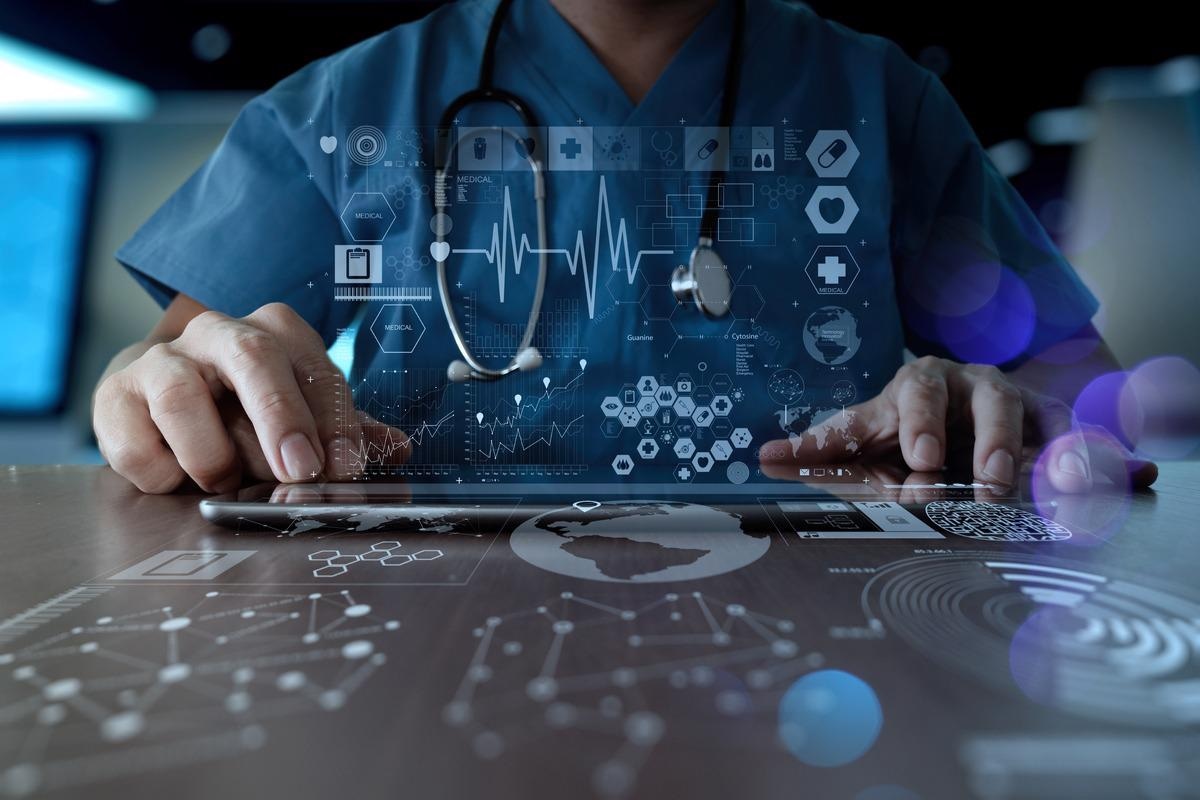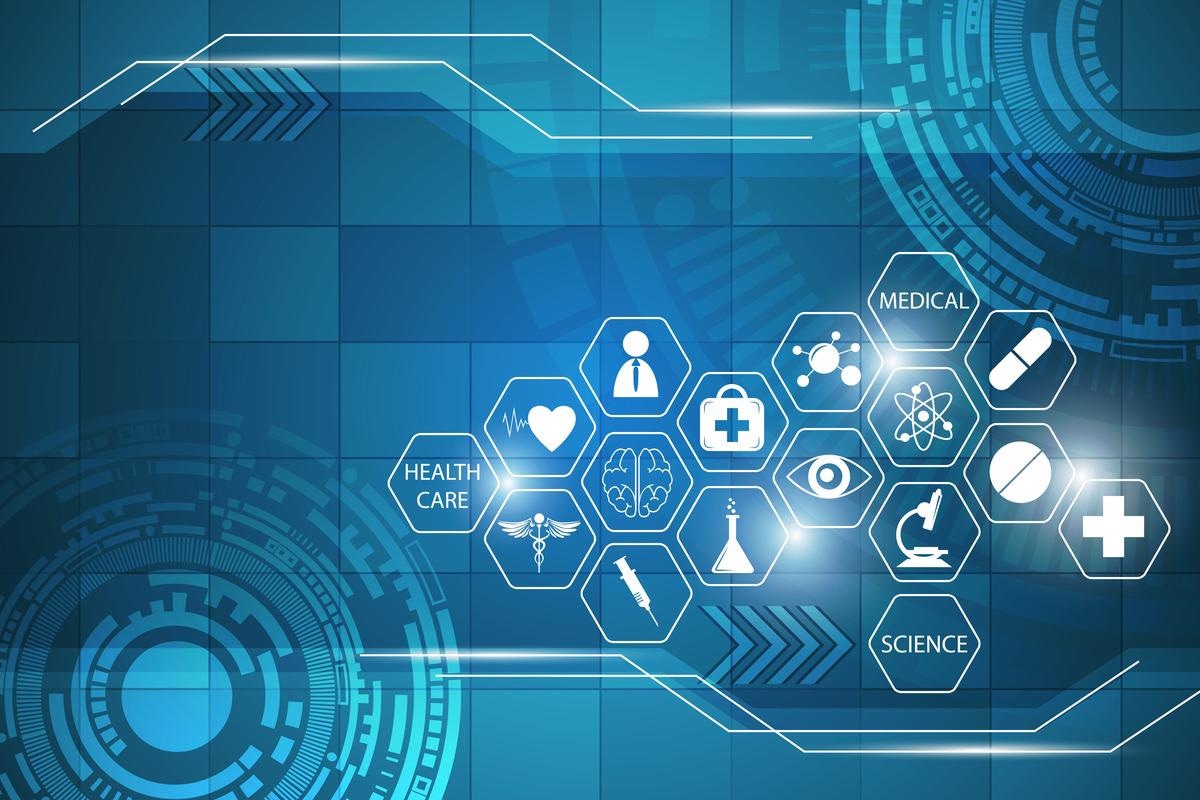Introduction
Artificial intelligence
The dark side
The rise of mHealth
Telemedicine
Virtual Reality
The internet of medical things
Digital twins
Blockchain
Cloud computing
Nanotechnology
3d printing
Primary prevention of disease
Neural chips
Big data analysis
Conclusion
References
Further reading
In times of crisis, immense creativity often comes to the fore, precipitating major changes. This has been the case in the coronavirus disease 2019 (COVID-19) era. Healthcare technology has leaped to the fore to help healthcare providers manage their patients better by reducing the dangers inherent in personal contact, waiting in crowded waiting rooms or laboratories, and hospitalizations.

Image Credit: everything possible/Shutterstock.com
Artificial intelligence
Artificial Intelligence (AI) technology is being used in the diagnosis of diseases, as well as to offer customized solutions. For instance, it is being used to drive systems that process computed tomography scans by the thousands, in a mass detection scenario, as in COVID-19. This spares radiographers and physicians to attend to patients, besides providing supplementary information and thus improving the accuracy of diagnosis and monitoring.
Machine learning is being exploited in the pharmaceutical industry to identify new drug candidates without the long and expensive traditional method of sifting through chemical libraries while also replacing actual experiments with simulations, varying multiple parameters. The whole process is not only much less expensive but also much faster.
Robotic systems are being developed using AI and machine learning to replace humans in the performance of routine unskilled tasks now being done by skilled healthcare practitioners. This will free them to treat more patients with less time pressure, promoting a favorable outcome.
The dark side
Even as AI is being used to help healthcare, it can be perverted to steal patient and provider identities, divert funds and misuse information by hacking medical computer systems. This can occur via private systems linked to hospital software, or by wireless networks at health facilities, or via the Internet of Things (IoT). Thus, the protection of such systems from AI-driven malware and personalized attacks would perhaps cost more than can be saved by the application of such systems.
Meticulous planning, effective training, and ongoing monitoring of healthcare and technical staff as they use data systems, as well as installing data security systems, are essential to prevent, detect and plug data breaches as soon as possible.
The rise of mHealth
To handle these needs, mobile health information and sensing technologies, termed mHealth, has gained prominence. These tools seem to offer the ability to provide healthcare at lower costs with improved outcomes. They can allow a limited number of providers to monitor more people, individually and at the population level.
Applications of mHealth can promote healthy behaviors for primary or secondary disease prevention, help with the self-management of chronic illnesses, improve provider training, and cut down on visits to the doctor. At the same time, they can help personalize interventions to an unprecedented level.
Today, mHealth can be utilized in the form of mobile devices, wearables, and other devices that allow people to carry on with their routine activities, while the device sends invaluable data on a host of parameters back to the server. This data can be used both in the present and the future to provide information on all kinds of trends and predictive factors to help research-driven efforts to promote and improve patient health.
Multiple platforms are now available, backed by top-class information technology (IT) firms like Apple, to facilitate the development of healthcare apps.
Telemedicine
Telemedicine is an important innovation now practiced in many countries worldwide due to pandemic restrictions on public travel. With this technology, clinical practitioners see patients virtually, avoiding personal contact, while still being able to diagnose and treat patients for a host of illnesses. The saving of time and money has made this an attractive option for both patient and practitioner, and this trend seems unlikely to die down soon.
Virtual reality
Augmented and virtual reality is being used in novel ways to distract nervous patients from surgical procedures or help train medical students outside the hospital and without the risk of harm to actual patients. A hands-free mode of operation is also enabled, allowing providers to access patient records or other information without leaving the patient or stopping the procedure they are engaged in.
The internet of medical things
The Internet of Medical Things (IoMT) comprises a network of devices and mobile phone apps that track and prevent serious events in the course of chronic illness, linking patients and doctors for better monitoring and management of such conditions. For instance, wearable electrocardiography (ECG) monitors can allow patients with troublesome changes to be identified early enough to abort heart attacks.
Other wearables may help monitor fever, blood sugar levels, or pulse. It is estimated that almost a third of the IoT (Internet of Things) market worldwide will henceforth come from the IoMT.

Image Credit: Supphachai Salaeman/Shutterstock.com
Digital twins
The ability to pair objects in a computer-generated virtual world can help to manipulate both objects at the same time – digital twins. This is important in the plethora of medical devices being marketed today, which are designed virtually in the confidence that the real-life object will be exactly like it in every way.
Moreover, models can be created for testing, with the results being quite reliable. Remote surgery is also based on this technology, saving time and expenses.
Blockchain
The use of blockchain technology is still controversial, but its potential to improve the secure, convenient, and rapid sharing of healthcare information between authorized providers and patients is becoming clearer by the day. The design of this tool allows for large numbers of users without compromising the safety of using a single ledger. This poses a formidable challenge to the current use of electronic health records, putting it alongside the IoMT and cloud computing as a worthy colleague.
Cloud computing
With patient data being a dynamic thing, it is essential that healthcare providers have a safe and smooth method to share and store this data on which their clinical decisions are based. Cloud computing offers an excellent way out whereby data collection, storage, and management can be achieved using a single point. The resulting improvement inpatient care, with the saving of time, is among the benefits of this approach.
Nanotechnology
The development of nanotechnology has given rise to many innovative systems of treatment. Xenobots, or self-replicating tiny organic robots, were reported by the end of 2021. A wide range of applications lies open to nanotechnology in medicine, including nanobots for the detection of disease by traversing microscopic blood vessels and nanoparticle drug delivery systems to accurately deliver toxic drugs to the cells that are their targets avoiding or reducing off-target effects.
3D printing
The ability to build body parts such as artificial veins, implants, bionic prostheses, customized surgical instruments, and produce pills is just part of the future with 3-D printing. Many medications are using this technology for faster, cheaper production.
Primary prevention of disease
Using all modern medical expertise and equipment, including lifestyle advice, it is estimated that patient outcomes change by up to 20% only, the rest being the product of social determinants of health (SDOH). When these are taken into account, doctors will soon be able to predict the course of the person’s health and prescribe preventive measures to arrest the deterioration of health in a timely manner, rather than deferring the recognition of such events to a later stage, when sophisticated and costly interventions will become necessary.
Neural chips
Companies are vying to bring out microelectrodes that can be implanted safely into the brain to restore some degree of functionality to people who have lost sight, for instance, or voluntary muscle activity.
Big data analysis
The storage of data in huge volumes in secure data siloes will help analysts to mine it for useful information that could help drive new research using AI and machine learning. Both of these identify and interpret patterns in the data that could be invisible to humans but could offer a chance to intervene for the patient’s benefit. Data sharing and interoperability norms will also be enforced to benefit patients.
Conclusion
“For medical technology, standards and regulations are needed to ensure safety, protect the public, and guarantee that products are fit for purpose. However, in the context of novel and personal medical technologies, the current approach to regulation is not only infeasible and difficult to enforce, but also work against health care innovation.” At the same time, with the realization that human nature remains the same and that the real aim of technology has always been profitability, it is obvious that newer health technologies need to be vigilantly monitored via new regulatory frameworks so that patients continue to be benefited and kept at the center of healthcare.
References
- Khristich, S. (2021). 17 Major Healthcare Technology Trends of 2022. https://tateeda.com/blog/healthcare-technology-trends.
- Thimbleby, H. (2013). Technology and the Future of Healthcare. Journal of Public Health Research. https://dx.doi.org/10.4081%2Fjphr.2013.e28. https://www.ncbi.nlm.nih.gov/pmc/articles/PMC4147743/
- Vincent, C. J. et al. (2015). Can Standards and Regulations Keep Up with Health Technology? JMIR mHealth and uHealth. https://doi.org/10.2196/mhealth.3918. https://mhealth.jmir.org/2015/2/e64/
- Kumar, S. et al. (2014). Mobile Health Technology Evaluation. American Journal of Preventive Medicine. https://dx.doi.org/10.1016%2Fj.amepre.2013.03.017. https://www.ncbi.nlm.nih.gov/pmc/articles/PMC3803146/
Further Reading
- All Artificial Intelligence Content
- Artificial Intelligence in Cardiology
- Artificial Intelligence and Deep Learning in Medicine
- Machine Learning in Drug Development
- Deep-Learning in Radiology
Last Updated: May 30, 2022

Written by
Dr. Liji Thomas
Dr. Liji Thomas is an OB-GYN, who graduated from the Government Medical College, University of Calicut, Kerala, in 2001. Liji practiced as a full-time consultant in obstetrics/gynecology in a private hospital for a few years following her graduation. She has counseled hundreds of patients facing issues from pregnancy-related problems and infertility, and has been in charge of over 2,000 deliveries, striving always to achieve a normal delivery rather than operative.
Source: Read Full Article